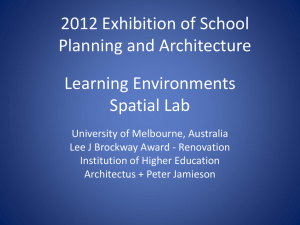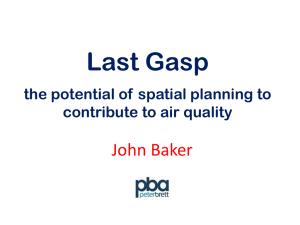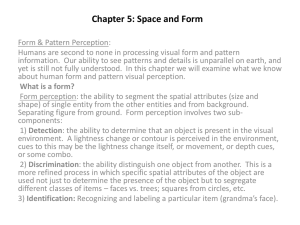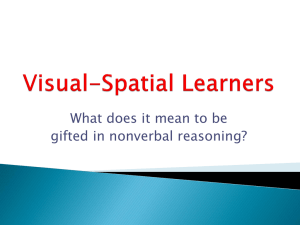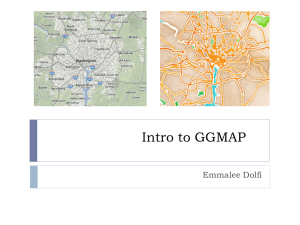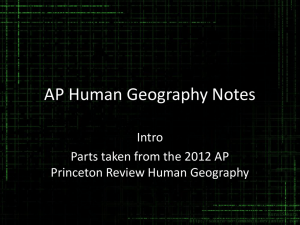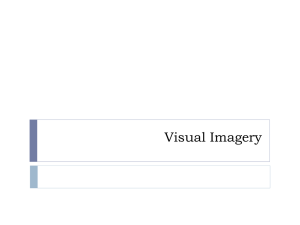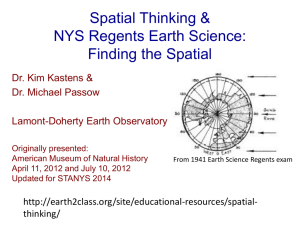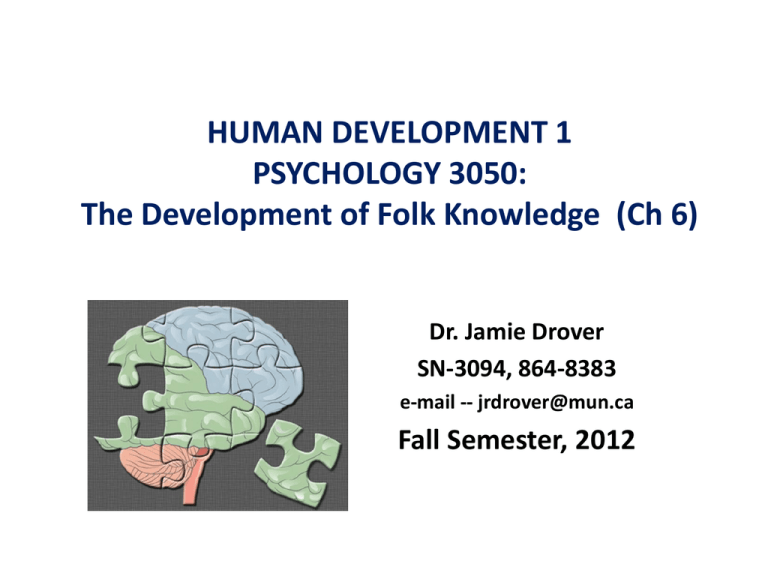
HUMAN DEVELOPMENT 1
PSYCHOLOGY 3050:
The Development of Folk Knowledge (Ch 6)
Dr. Jamie Drover
SN-3094, 864-8383
e-mail -- jrdrover@mun.ca
Fall Semester, 2012
Theory Theories
• We have innate theories that we modify during
childhood.
• A theory is tested and then revised when it no longer
explains new data.
• We have innate knowledge, or processing constraints
in certain domains.
– Neonativism
2
Theory Theories
• They integrate innate knowledge with
constructivism.
• The cognitive processes that undergo gradual
constructivist development are actually innate.
• They require specific motor and/or sensory skills.
– Object permanence
– Very young infants can show this ability when tasks are
modified.
3
Theory Theories
• Gopnik and Meltzoff propose that children are born
with sets of rules for operating on particular
representations.
• These rules are altered by experience.
• Development is still constructive.
• The child has a particular theory.
• There is disorganization.
• A new coherent theory emerges.
4
Developing a Theory of Mind
• Recognizing different categories of mind, such
as dreams, memories, beliefs, etc.
• Includes the ability to understand that other
people have beliefs, desires and intentions
that are different from one's own.
• A theory to understand, predict, and explain
behavior.
Development of Theory of Mind
• Adult theory of mind is based on belief-desire
reasoning.
• We explain and predict what people do based
on what we understand their beliefs and
desires to be.
– Referring to wants, wishes, hopes, and goals, and
to their ideas, opinions and knowledge.
Skills Underlying Theory of Mind
• Viewing oneself and others as intentional
agents.
• Individuals who cause things to happen and
whose behavior is designed to achieve some
goal.
• The ability to take the perspective of another
person, i.e., understand the intentions of
others.
Skills Underlying Theory of Mind
• This knowledge develops over the first few
years of life, beginning with shared attention.
• A triadic interaction between two partners
and a third object.
– Appears at about 9 months.
– At 12 months, they point to things that others
aren’t aware of.
– At 12 to 18 months, they use the gaze of others to
achieve shared attention.
Skills Underlying Theory of Mind
• There is early evidence that infants and toddlers view
others as intentional agents.
• More likely to copy the behavior of a model who is
engaged in the action on purpose.
– See Carpenter et al (1998) p 202.
– See Meltzoff (1995) p 202.
The Development of Mind Reading
• Researchers have developed several tasks to assess
when and how children develop this latter aspect of
theory of mind.
• False-belief task: a child watches as a candy is
hidden in a special location.
• Another child is present when the candy is hidden.
• The hidden candy is then relocated.
The Development of Mind Reading
• Child is asked whether the
other child will know the
location of the candy.
• 4-year-olds can solve the
problem. 3-year-olds can not.
• A variation of this is the
Smarties task.
• Suggests that children are
unable to remember their
original belief.
The Development of Mind Reading
• Young children have difficulty with contradictory
evidence.
• Can’t deal with two representations of a single object
simultaneously.
– Similar to the dual-representation hypothesis.
– Young children will fail in situations where they must
consider two beliefs or representations for a single target.
The Development of Mind Reading
• Gopnik and Astington assessed 3, 4, and 5 year-old’s
abilities to solve tasks that require children to deal
with contradictory evidence (See Fig 6-2 p 204).
– Performance varied with age.
– A domain-general mechanism underlies representational
abilities.
The Development of Mind Reading
• Young children lack executive function.
– Cognitive abilities involved in planning, executing, and
inhibiting actions.
– In theory of mind tasks, children often have to inhibit a
dominant response to pass the task.
• See the mean monkey example (p. 205).
• Note however, 3-year-olds can solve other tasks that
require an understanding of other’s minds.
The Development of Mind Reading
• See p. 206 (Clemens & Perner, 1994)
– Implicitly, children were correct.
– 3-year-olds have an implicit understanding of false belief
that exceeds their verbal understanding.
• In some studies, 18-month-olds show the beginnings
of theory of mind.
– See page 207 (Repacholi & Gopnik, 1997).
The Development of Mind Reading
• Performance on false beliefs task are related to
family size.
– Children from larger families perform better.
– This only helps if one has older siblings.
– Important for children with low language skills.
Deception
• When children play tricks on others, they seem to be
aware of what the other person does and does not
know.
• 2- and 3-year-olds are often capable of deception.
• See p. 210 (Chandler et al. 1989)
– 2.5 to 4 year-old children showed several types of
deception.
– Withhold evidence, destroy evidence, lying, producing
false evidence.
Hiding Containers
Sponge
Footprints
Main
Container
Deception
• Even 2.5-3 year-olds will engage in deceptive
practices to instill false beliefs in others.
• See page 255 (Hala & Chandler, 1996; Sullivan &
Winner, 1993).
Do 3-Year-Olds Have a Theory of Mind
• Currently there is debate whether 3-year-olds possess
theory of mind.
• Most researchers agree that 3-year-olds appear to
have a limited knowledge of other’s minds.
• Some argue that 3-year-olds have competence, but
the nature of the task prevents them from showing it.
• Others argue that there is real conceptual change
during the preschool years.
Do 3-Year-Olds Have a Theory of Mind
• Wellman et al. (2001) conducted a metaanalysis of 178 studies.
• They found age effects which support the
conceptual change position.
Theory of Mind, Evolved Modules, and Autism
• Some theorists believe that Theory of Mind evolved
during the course of human evolution and is the
basis of social intelligence.
• It’s assumed that we have domain-specific modules
to handle theory of mind.
• According to Baron-Cohen (1995), there are four
interacting modules involved in mindreading that
develop in the first 4 years.
Theory of Mind, Evolved Modules, and Autism
1. Intentionality Detector (ID): interprets moving
objects as having some intention
2. Eye Direction Detector (EDD): Detects the
presence of eyes. Determines when another
organism is looking at them. Develops between
birth and 9 months.
3. Shared Attention Mechanism: Involves three-way
interactions. Develops from 9-18 months.
Theory of Mind, Evolved Modules, and Autism
4. Theory of Mind Module: Understanding that
others have different beliefs, desires, and
intentions (develops between 18 and 48 months).
The Empathizing System
• Baron-Cohen proposed The Emotion Detector (TED)
which develops by 9 months of age.
• It can represent affective or emotional states
between two people.
• Within 6 months of life, infants can pick up on the
emotions of others.
• At 9 months, the info derived from TED can be
converted into a triadic representation of the SAM.
The Empathizing System
• The Empathizing SyStem (TESS) is online at 14
months of age.
• It permits an empathic reaction to another person’s
emotions, and assumes there is an associated drive
to help others.
Mindblindness
• The inability to read minds.
• Advanced forms of mindreading and empathizing are
absent or delayed in children with autism.
• Autistic children fail false-belief and theory of mind
tasks but can pass nonsocial tasks.
• They perform well on tasks requiring the ID and EDD
modules, but not those requiring SAM or Theory of
mind.
Mindblindness
• Children with Down Syndrome perform well on
theory-of-mind tasks, but perform poorly on tasks of
intelligence.
The Development of Spatial Cognition
• Processing information with respect to their spatial
relations.
• Coding information about the environment.
• Knowing where something is in relation to you, or in
relation to other objects and locations.
• See Table 6.4
Spatial Orientation
• How people understand the
placement of objects in space
with themselves as a
reference point.
• Eg. Distinguishing geographic
directions in an unfamiliar
locale, drawing your way from
point A to B on a map.
• Relatively well-developed in
preschool.
– See Huttenlocher & Vasilyeva
(2003) on p 227
– See Newcombe et al. (1999) on
p 227
Spatial Orientation
• Older children are even more advanced…can form
cognitive maps.
– i.e., 5, 7, and 10-year-olds could re-create the layout of a
large model town based on memory (Herman & Siegel,
1978).
– Got better with age.
• They get better at using real maps over the school
years.
– Adultlike by age 10
Spatial Orientation
• Uttal et al. (2001) showed 3, 4, and 5-year-olds
yellow carpet with 27 cups on it.
• They had to find stickers under some cups using a
map.
• The maps included lines for half the kids, no lines for
the other half.
• Children got better with age.
• Lines improved the performance for 5-year-olds.
Spatial Orientation
• Maps are a tool of intellectual adaptation that can
eventually be internalized.
• There is a reciprocal relationship between maps and
spatial cognition.
• Uttal & Wellman (1989) had 4 to 7-year-old children
learn which of 6 animals went into each of 6 rooms
in a life-sized playhouse.
– Children learned the locations based on a map or on flash
cards.
Spatial Orientation
• The children who learned with the map performed
better on a “walk-through.”
• The experience with the map allowed them to more
easily see spatial relationships among elements.
Spatial Visualization
• Involves visual/mental operations.
• Often assessed using mental rotation.
– A stimulus must be rotated to see if it matches another.
• Even 4 and 5-year-olds can do this.
• Adults can have problems with complex stimuli.
Spatial Visualization
Spatial Visualization
• Piaget and Inhelder
(1967) tested
spatial visualization
using the waterlevel problem.
• Most children can
do this by age 7.
Object and Location Memory
• Remembering objects and their positions.
• Often tested using card games.
• Young children (5 yrs) perform almost as well as
adults early in these games.
– Strategies are less important.
Sex Differences in Spatial Cognition
• There are sex differences in spatial cognition that
may have been selected for through the course of
evolution.
• Males needed to develop spatial abilities in order to
navigate (Geary, 2007).
• Sex differences in map reading and mental rotation
have been found in preschool years.
– Mental rotation differences may exist in infancy.
Sex Differences in Spatial Cognition
• According to meta-analyses, the magnitude of sex
differences is very small.
– Only 1 to 5% of the difference is due to gender.
– Mental rotation is especially prominent.
• Females show better performance in object and
location memory.
• May be due to evolution…role as gatherers.
– Must be able to perceive small stimulus differences.
Sex Differences in Spatial Cognition
• Differential experiences may also play a role.
• Newcombe et al. (1983) asked college students to
classify activities as masculine, feminine, or neutral
(see Table 6-5).
• Tasks with high spatial content were considered
masculine.
• They found a gender difference on a test with strong
spatial components.
Sex Differences in Spatial Cognition
• The more spatial activities one engages in, the
greater one’s spatial ability.
Object-Oriented Play and Tool Use
• Object-Oriented Play: manipulation of objects
(banging or throwing), including the use of objects to
build something.
• Difficult to distinguish from exploration.
• Often involves making noise.
Object-Oriented Play and Tool Use
• Play eventually becomes more sophisticated.
– Building things --- boys more likely.
– May be a biological origin.
Object-Oriented Play and Tool Use
• Preschoolers spend 10 to 15% of their time
engaged in object play.
• This object play allows children to learn how
objects can be used as tools.
– This is something very few species can do.
Learning to use Tools
• Common in problem
solving: forks, pens,
hammers, etc.
• Non-humans also use
tools to solve problems
Learning to use Tools
• May originate from infants’ manipulation of their
physical world (Lockman, 2000)
• It’s a gradual process of discovery that arises from
infants’ and children’s interaction with objects in the
real world to achieve a perceptual outcome.
The Development of Tool Use in Young Children
• Piaget speculated that infants could use tools by their first
birthday.
• 9- to 12 mo-old infants learn to solve lure-retrieval problems
– E.g., can use a stick to reach toy outside playpen
• Chen and Siegler (2000): systematic study of tool use in
toddlers: 18- to 30-mo
– Child seated across from out-of-reach toys
– Several tools available
– Only one will retrieve the toy
– Three trials – encouraged to get toy
– Hint and modeling conditions given
The Development of Tool Use in Young Children
The Development of Tool Use in Young Children
The Development of Tool Use in Young Children
• 30 mo – no instruction:
– more likely to use tools to get toy than 18-mo-olds without
instruction (15% vs. 0%)
– With instructions (hint) or modeling (social learning)
• 30-mo improved; some 18-mo use tool to get toy
• Type of strategies used
– Forward: lean forward to get toy
– Indirect: ask for help
– Tool use: use one of the tools
• Strategy use changed across trials
– Tool strategy increased but forward and indirect continued
to be used.
The Development of Tool Use in Young Children
• Boys were more likely than girls to choose a tool use
strategy.
The Design Stance
• Once a person sees someone
use a tool achieve a goal,
he/she assumes the tool was
designed for that purpose.
– Leads to efficiency and
functional fixedness.
• Even 12-month-olds learn
that some tools are special
purpose objects.
– See Barrett et al (2007) on
page 238.
The Design Stance
• Young children select a tool based on past history,
not based on its properties to solve a problem.
The Relationship between Tool Use and ObjectOriented Play
• The tendency to play with objects can
influence tool use.
• In some studies, children must select a
properly shaped tool to retrieve a toy.
• Those who are given the opportunity to play
with the objects beforehand are more likely to
use them later as tools.
The Relationship between Tool Use and ObjectOriented Play
• This can lead to gender differences.
Children’s Understanding of Time
• 2 and 3-year-olds can use temporal terms (yesterday,
last night, tomorrow), but often use them incorrectly.
• By age 4, they understand before and after, but have
trouble understanding the recency of events.
• 4 and 5-year-olds can distinguish between the events
that happen during the course of the day, but have
trouble with events occurring at longer intervals.
Children’s Understanding of Time
• Even 6 and 7-year-olds have trouble thinking
about days of the week, or months in relation
to each other.

